|
![]()
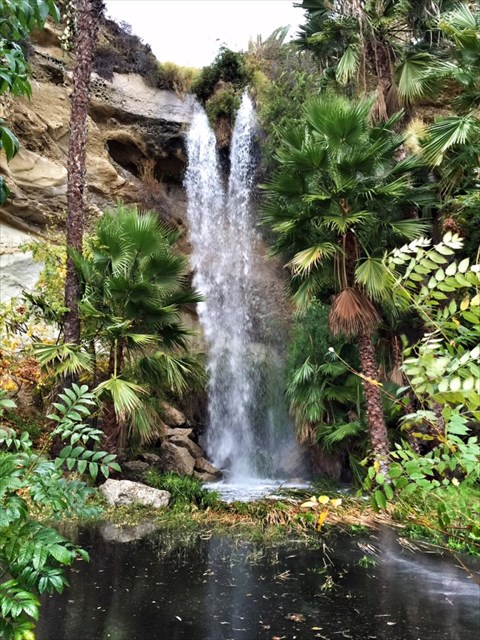
The reason I chose this area for this Earthcache is because of what I like to call a "Hidden Gem". It combines a plethora of interesting things to learn about, all made by nature over millions of years ...and a not-so long ago feature made by man with the help of mother nature. What feature might that be? Take a look at the picture above of the waterfall. The amazing sight is a brand new surprise for visitors to the harbor, but for locals it’s sort of a secret...UNTIL it rains. If you want to see the waterfall, the best time to visit this location is after a heavy downpour or multiple days of rain.
![]()
The Southern California coastline is made up of many different types of sedimentary rocks. Five of the most common in this area are conglomerate, breccia, sandstone, shale and siltstone.
![]()
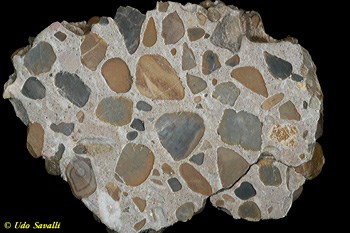
Conglomerate is a clastic sedimentary rock that contains large (greater than two millimeters in diameter) rounded clasts. The space between the clasts is generally filled with smaller particles and/or chemical cement that bind the rock together.Conglomerate forms where a sediment of rounded clasts at least two millimeters in diameter accumulates. It takes a strong water current to transport and shape particles this large. So the environment of deposition might be along a swiftly flowing stream or a beach with strong waves. There must also be a source of large-size sediment particles somewhere up current. The rounded shape of the clasts reveal that they were tumbled by running water or moving waves.
![]()
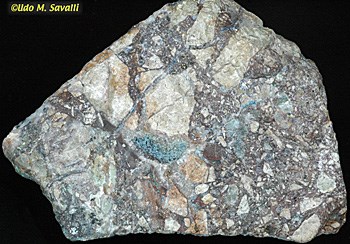
Breccia is very similar to conglomerate. The main thing that is different is that the pebbles in breccia have not been rounded by the action of moving water as in a conglomerate. Breccia is made up of angular pebbles cemented together. The size of these rock fragments is over 2 mm in diameter. After the pebbles have been deposited they are compacted by the sediments that pile up on top of them. Over very long periods of time the pebbles become cemented together by minerals. Silica, calcite, and iron oxides are the most common cementing minerals. The angular pebbles in the breccia are easily visible to the naked eye.
![]()
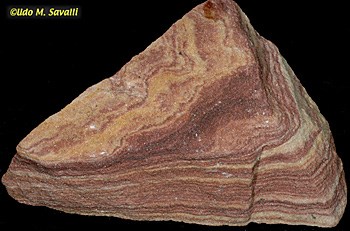
Sandstone is a sedimentary rock composed of sand-sized grains of mineral, rock or organic material. It also contains a cementing material that binds the sand grains together and may contain a matrix of silt- or clay-size particles that occupy the spaces between the sand grains. Sandstone is one of the most common types of sedimentary rock and is found in sedimentary basins throughout the world. It is often mined for use as a construction material or as a raw material used in manufacturing. In the subsurface, sandstone often serves as an aquifer for groundwater or as a reservoir for oil and natural gas.
![]()
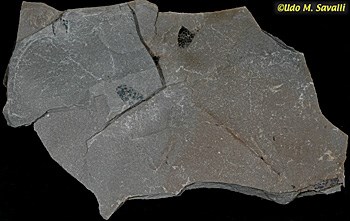
Shale is a sedimentary rock formed in ancient marine environments. It is more commonly called a "mudrock" because it is composed of silt and clay particles slowly deposited through suspension in calm waters. Silica and calcium carbonate from marine creatures provides the cement necessary to eventually form the rock. As the marine environment dries during various epochs of climate change, sedimentary rock is left behind. Shale is formed in an environment that consists of calm water: for example, water near the shores of large lakes or continental shelves at sea edges. The calmness of the water enables suspended particles like clay to eventually sink and settle in the bottom of the lake or sea. Silica and calcium carbonate from marine life, particularly from shells, also settle with the clay particles, and over time they form cement for the clay particles to "lithify" -- that is, become rock -- and form shale. When extensive organic material such as from plankton and plants becomes embedded with the shale, oil shale can form.
![]()

Siltstone is a sedimentary rock composed mainly of silt-sized particles. It forms where water, wind, or ice deposit silt and the silt is then compacted and cemented into a rock. Silt accumulates in sedimentary basins throughout world. It represents a level of current, wave or wind energy between where sand and mud accumulate. These include fluvial, aeolian, tidal, coastal, lacustrine, deltaic, glacial, paludal, and shelf environments. Sedimentary structures such as layering, cross-bedding, ripple marks, erosional contacts, and fossils provide evidence of these environments. Siltstone occurs in a wide range of colors. It is usually gray, brown, or reddish brown. White, yellow, green, red, purple, orange, black and other colors occur. The color is caused by the composition of the grains, the composition of the cement that binds them together, and stains produced by contact with subsurface waters.
![]()
Siltstone and shale are a type of sedimentary rock called clastic rock, which forms when "clasts" -- that is, fragments of other rocks or minerals -- are deeply buried and compacted in a depression. In the case of siltstone and shale, the clasts are silt and clay particles. Over time, the buried sediment becomes cemented and forms sedimentary rock. Geologists can date sedimentary rocks relative to each other, because older rock is buried beneath younger rock. Siltstone is deposited in a similar environment to shale, but it often occurs closer to the shoreline of an ancient delta, lake or sea, where currents cause less suspension of particles. Siltstone commonly occurs adjacent to sandstone deposits -- that is, near beaches and delta edges where sand is deposited. Silt, hence siltstone, occurs in the water adjoining the sandy beaches and deltas, which filters the smaller silt particles. The siltstone will grade into shale in deeper water where the suspended clay particles are more abundantly deposited. In either case, calm waters are needed for the suspension and sorting of silt and clay. Thus, sandstone, siltstone and shale are interrelated rocks that are distinguished by particle size.
To log a find on this cache, you must E-MAIL me the correct answers. If any of your answers are wrong, I will email you and let you know.
![]()
1. Put "Dana Point's Hidden Gem" in the subject line of your email.
![]()
2. There are different rocks at the base of the waterfall. Of the five rock types named above, which type is the most prominent?
![]()
3. When looking at the area of the waterfall, on the east (right hand) side, there is siltstone that has "sandwiched" another type of rock that stands out from the siltstone. Describe the rock you see in between the two layers of siltstone.
![]()
4. When looking at the area of the waterfall, on the west (left hand) side, high above, there is erosion in the cliff face just below the cactus. What do you think caused this type of erosion?
![]()
5. At N 33° 27.801 W 117° 42.093 there are two large boulders. What sedimentary rock are these two boulders made of? (Two different answers)
![]()
6. Optional: Post a picture of you at the falls.
![]()
Works Cited
http://www.savalli.us/BIO113/Labs/02.Rocks.html
![]()
https://olliuci.files.wordpress.com/2015/12/uci-talk-geology-of-socal-coastal-areas-3-26-12.pdf
![]()
http://geology.com/rocks/siltstone.shtml
![]()
http://www.rocksandminerals4u.com/breccia.html
![]()
http://geology.com/rocks/conglomerate.shtml
![]()
http://classroom.synonym.com/environment-likely-form-siltstone-shale-6627.html
![]()
https://en.wikipedia.org/wiki/Sandstone
![]()
|